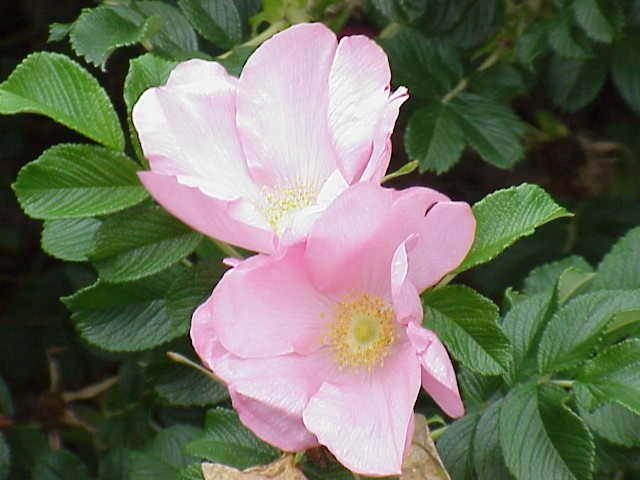- Rosa rugosa
Taxobox
name = "Rosa rugosa"
status = secure

image_width = 240px
image_caption = "Rosa rugosa" flower
regnum =Plant ae
divisio = Magnoliophyta
classis =Magnoliopsida
ordo =Rosales
familia =Rosaceae
subfamilia =Rosoideae
genus = "Rosa"
species = "R. rugosa"
binomial = "Rosa rugosa"
binomial_authority = Thunb."Rosa rugosa" (Rugosa Rose, Japanese Rose, or Ramanas Rose) is a species of
rose native to easternAsia , in northeasternChina ,Japan ,Korea and southeasternSiberia , where it grows on thecoast , often onsand dune s.Vernacular names
In Japanese, it is called nihongo|"hamanasu"|ハマナス, meaning "shore pear". In Korean, the species is called "haedanghwa" (해당화, linktext|海|棠|花), literally "flowers near seashore". [cite web|url=http://www.nature.go.kr/plant/plantGuide/results/view.jsp?name_id=13169&returnUrl=%2Fplant%2FplantGuide%2Fsearch%2Fgeneral.jsp%3Fplant_name%3D%C7%D8%B4%E7%C8%AD%26size%3D10%26init_check%3DY%26start%3D1%26selLang%3DK |title=Haedanghwa (해당화) |publisher=Korea National Arboretum |language=Korean |accessdate=2008-08-06]
Features
It is a suckering
shrub which develops new plants from the roots and forms dense thickets 1–1.50 m tall with stems densely covered in numerous short, straight thorns 3-10 mm long. The leaves are 8–15 cm long, pinnate with 5–9 leaflets, most often 7, each leaflet 3–4 cm long, with a distinctly corrugated (rugose, hence the species' name) surface. Theflower s are pleasantly scented, dark pink to white, 6–9 cm across, with somewhat wrinkled petals; flowering is from summer to autumn (June to September in the northern hemisphere).The hips are large, 2–3 cm diameter, and often shorter than their diameter, not elongated like most other rose hips; in late summer and early autumn the plants often bear fruit and flowers at the same time. The leaves typically turn bright yellow before falling in autumn.
Cultivation and uses
Rugosa Rose is widely used as an
ornamental plant . It has been introduced to numerous areas ofEurope andNorth America . It has many common names, several of which refer to the fruit's resemblance to atomato , including beach tomato or sea tomato; saltspray rose and beach rose are others.The sweetly scented flowers are used to make pot-pourri in Japan and
China , where it has been cultivated for about a thousand years.This species hybridises readily with many other roses, and is valued by rose breeders for its considerable resistance to the diseases
rose rust androse black spot . It is also extremely tolerant of seaside salt spray andstorm s, commonly being the first shrub in from the coast. It is widely used in landscaping, being relatively tough and trouble-free. Needing little maintenance, it is suitable for planting in large numbers; its salt-tolerance makes it useful for planting beside roads which need deicing with salt regularly.Numerous
cultivar s have been selected for garden use, with flower colour varying from white to dark red-purple, and with semi-double to double flowers where some or all of thestamen s are replaced by extra petals. Popular examples include 'Fru Dagmar Hastrup' (pink, single), 'Pink Grootendorst' (pink, semi-double), 'Blanc Double du Coubert' (white, double) and the more common 'Roseraie de L’Hay' (pink, double) which is often used for its very successful rootstock and its ornamental rose hips.Gallery
References
* [http://www.blackwell-synergy.com/links/doi/10.1111/j.1365-2745.2005.01002.x/abs/ Biological Flora of the British Isles "Rosa rugosa"]
* [http://www.efloras.org/florataxon.aspx?flora_id=2&taxon_id=200011310 Flora of China: "Rosa rugosa"]
*Huxley, A., ed. (1992). "New RHS Dictionary of Gardening". Macmillan.
Wikimedia Foundation. 2010.
